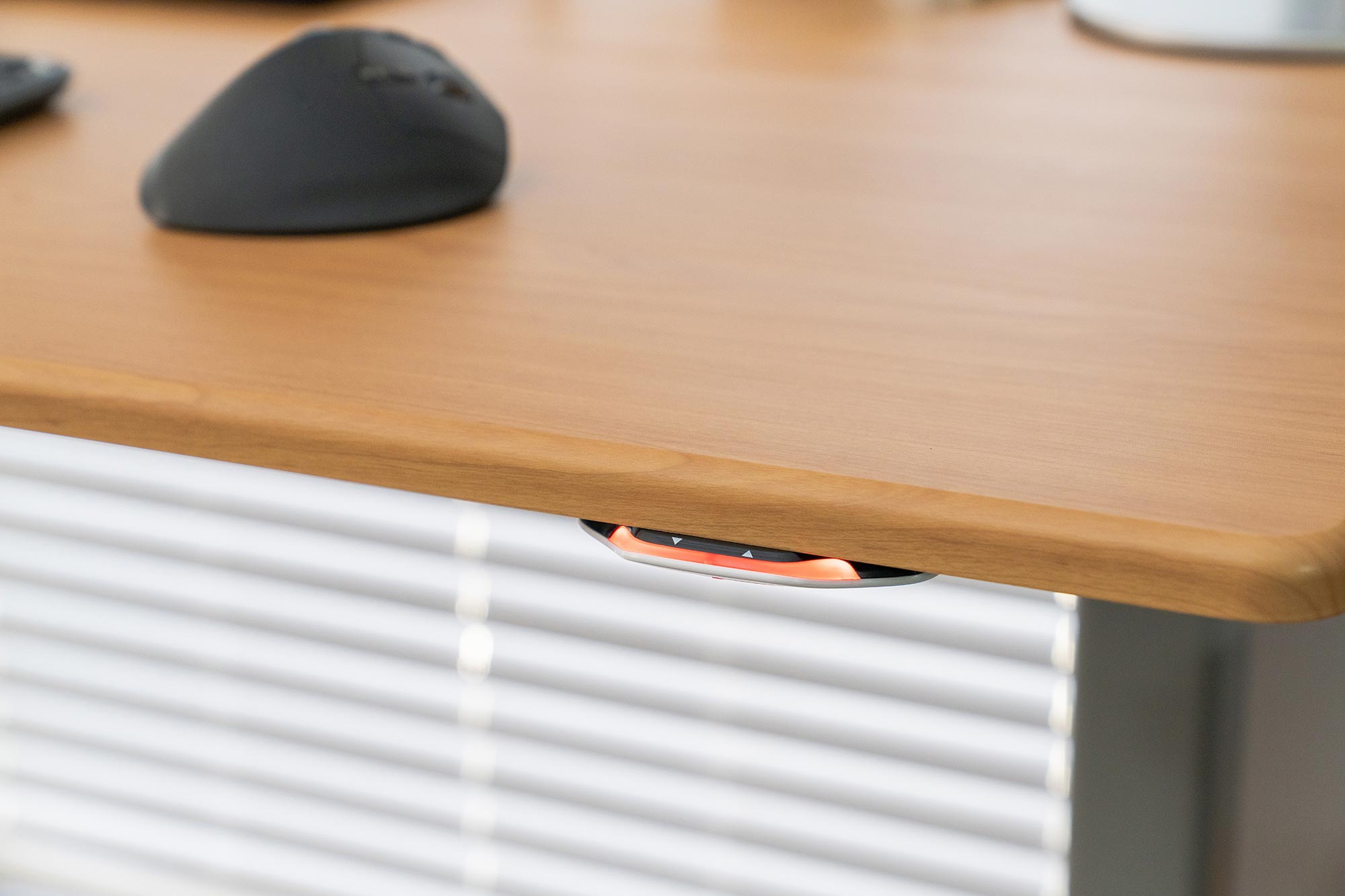If you’re just getting into the world of office fitness, you’re probably exploring the different options in the category known as active workstations. Treadmill desks and desk cycles are popular products that enable you to stay active at your desk. Desk cycles are less expensive than treadmill desks, and they aim to accomplish the same general goal: adding more movement into your sedentary lifestyle. You may be wondering, “Why should I go with a more expensive option that does essentially the same thing?” The truth is that these products aim to accomplish very different things.
What is a treadmill desk?
A treadmill desk is any integrated system with a treadmill and an adjustable-height desk. It should ideally be an office treadmill, designed for walking rather than running, like the Unsit Office Treadmill. The treadmill and the desk are not connected (though they can be in some models). You can perform all your normal desk activities while walking.
 Pros of a Treadmill Desk: Treadmill desks provide NEAT, or Non-Exercise Activity Thermogenesis. This means that you get to stay active without shifting into full blown cardio mode—you shouldn’t be sweating or breathing heavily while on your treadmill desk, you should be working and walking in harmony. Treadmill desks get your calf muscles moving, and they increase your basal metabolic rate. They’re proven to help with obesity, diabetes, and triglyceride levels.
Pros of a Treadmill Desk: Treadmill desks provide NEAT, or Non-Exercise Activity Thermogenesis. This means that you get to stay active without shifting into full blown cardio mode—you shouldn’t be sweating or breathing heavily while on your treadmill desk, you should be working and walking in harmony. Treadmill desks get your calf muscles moving, and they increase your basal metabolic rate. They’re proven to help with obesity, diabetes, and triglyceride levels.
They emulate a natural human behavior of thinking while walking, as opposed to thinking while sitting at rest for eight+ hours a day. You may find that your mental acuity goes up when using a treadmill desk. If you’ve ever tried doing math while running, you know that it’s exceptionally hard—but because treadmill desks are designed for low speed use, you get the benefit of movement without the detriment (to your thinking capacity) of cardio. Finally, the positive effects of treadmill desking have been studied and there are more results posted in their support than the newer desk cycles. They lead to reported lower levels of stress and higher feelings of satisfaction vs. desk cycles.
Cons of a Treadmill Desk: The hard truth is that treadmill desks take up more space and are more expensive. There’s no getting around that. If you’re looking to convert your office cubicle into an active workstation, your company’s policy may not reimburse you sufficiently, or you may not be able to fit the treadmill in the first place. The good news is that your increased productivity and health will save you and your company money in the long run.
What is a desk cycle?
The term “desk cycle” can refer to a few different products. It generally refers to a pedaling device that’s placed under the desk, allowing you to exercise at your workstation. These can either provide a circular motion, like standard bicycles, or an elliptical motion.
Here’s where it gets tricky: some people also use the term desk cycles to refer to desk bikes, which are a different animal entirely. Desk bikes are all-in-one products featuring a peddler and an attached work surface. These are not necessarily viewed as office fitness products. Desk bikes can be viewed as tackling the problem from a different direction—they aim to inject productivity into your exercise time, while other products aim to inject activity into your work day.
 One thing is common between desk cycles, desk ellipticals, and desk bikes: you are getting cardio exercise, and you it will be difficult to perform your normal office work while you’re cycling. For the purposes of this article, we will be referring to all of these products as desk cycles.
One thing is common between desk cycles, desk ellipticals, and desk bikes: you are getting cardio exercise, and you it will be difficult to perform your normal office work while you’re cycling. For the purposes of this article, we will be referring to all of these products as desk cycles.
Pros of a Desk Cycle: Desk cycles have a lower buy-in cost than treadmill desks, and they’re generally easy to fit into tight environments. They can provide a true cardio workout, albeit not while you’re working.
Cons of a Desk Cycle: The main problem with desk cycles is that cycling requires more mental energy than walking, which is a “built-in” natural motion. Even when cycling slowly, your ability to concentrate on work decreases. After a brief acclimation period, treadmill desking doesn’t really stop you from doing anything you’d otherwise do at your desk. The same cannot be said for cycling. You may get a better cardio workout, but you can’t expect a better work day.
One possible solution is to use your cycle sparingly, ie, between rounds of typing. You want to stay below the cardio level so you don’t negatively affect your concentration. Alternatively, you can go full cardio on your desk cycle while consuming content, like watching videos or reading, which should not be as impacted by strenuous activity.
The bottom line: If you work in an office, a treadmill desk is the clear winner. It enhances rather than detracts from your ability to work. It gives you the ability to walk slowly throughout the day, just like your body was designed for. Desk cycles are better for enthusiasts looking for a workout while watching videos, but not as part of a true active workstation where you’re typing and performing other computer tasks.
Setting Up Your Standing Desk
You’ve finally got your standing desk, and you’re wondering what to do next. Or perhaps you’re waiting for your standing desk to arrive, and you want to get a headstart on better health as soon as it does. Either way, this short guide will help you hit the ground running (or perhaps standing) with your new height-adjustable workstation.
 First, prepare your space. Make sure you have a level surface on which to place the desk. This will ensure that the linear actuators (the legs) of your desk operate at peak efficiency. If your desk is not level, you may find your desk straining and squeaking when elevating, especially when bearing heavier loads. All iMovR desks come with leveling pads installed on the feet. This means that even if your surface is slightly uneven, as most are, you can use the leveling pads to compensate, reducing the strain on the adjustable legs of your desk.
First, prepare your space. Make sure you have a level surface on which to place the desk. This will ensure that the linear actuators (the legs) of your desk operate at peak efficiency. If your desk is not level, you may find your desk straining and squeaking when elevating, especially when bearing heavier loads. All iMovR desks come with leveling pads installed on the feet. This means that even if your surface is slightly uneven, as most are, you can use the leveling pads to compensate, reducing the strain on the adjustable legs of your desk.
Next, you’ll need to assemble the desk (unless you’ve selected the factory pre-assembly option). If your desk requires assembly, we also suggest placing a blanket on the ground to prevent damage to the floor or scratches to the tabletop while it’s upside down.
Instructions are included with your iMovR desk. All iMovR tops are pre-drilled, so you will not need to drill any holes to assemble the desk—the only tool you’ll need is a screwdriver. Depending on your desk, the process should take 5-30 minutes, and it goes even faster with a friend. You can always opt for iMovR’s factory pre-assembly or white glove delivery to skip this step entirely.
Finally, configure your desk to ensure proper ergonomics. It will take some time to get your desk to the correct height for you. Try to set your desktop height so that the top of your monitor is eye-level, and your wrists are not flexed too far upward or downward while typing—your hands should be just slightly angled upwards in relation to your forearms. There’s a lot more to say on ergonomics—please check out our dedicated guides on the subject.
Note for DIYers
If you’re looking to assemble a desk not composed entirely of iMovR parts, you’ll have to put in some additional elbow grease. You’ll probably require a power drill to attach the tabletop to the base. We recommend vacuuming your work area before starting, as well as putting your tabletop on a blanket to protect the finish. Remember not to overload your iMovR base with too heavy a tabletop—the base weight ratings refer to the capacity of the base excluding tabletop.
What about weight rating?
Additionally, while considering your desktop’s setup, you should consider the amount of stuff on your desk in regards to weight rating. Too much clutter is not only distracting but can affect the performance of your desk’s motor as well. Remember that your tabletop does not factor into the weight rating of your base. Then, you’ll have to account for the weight of your computer, monitor and monitor arms, and any other accessories like printers.
Another factor is that objects will likely be unevenly distributed along your desktop, creating what’s known as side-load stress. For instance, your monitor arms are mounted to the back edge of your desk, which creates more stress than objects in the center of the desktop. The weight limit for your desk may be lower if most of the weight is side-loaded. Be cautious as you start to approach the weight limit for your desk, as you may end up reducing the lifespan of the motor in the long run. This issue can be compounded if the desk is not level.






